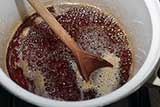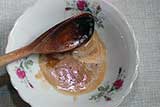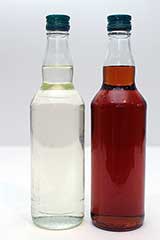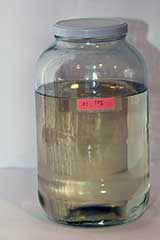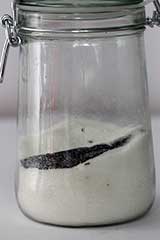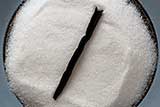Meats and Sausages
Sugar
Refined white sugar, whether cane or from sugar beets is fine. Adding brown sugar to light colored beverages should be avoided as it may darken your product. Sugar is diluted in water first and only then added to the fruit mixture. Pure alcohol does not mix with sugar, but will mix with sugar syrup. Sugar (sucrose) molecules are polar; they have a positive and a negative end. Water molecules have the same property. For this reason, the positive end of a sugar molecule will be attracted to the negative end of a water molecule and dissolve. Alcohols are non-polar and are equally charged on all sides. The charged ends of the sucrose have nothing to be attracted to except other sugar molecules, therefore they will not dissolve in pure alcohol.
There is a limit to the maximum amount of sugar that can dissolve in a given volume of water and this is known as a saturated solution. Adding more sugar will result in sinking it to the bottom and will create an unappetizing drink. This is dependent on the volume and temperature of water. Browne in his "Handbook of Sugar Analysis" states that, at 20° C (68° F), 204 grams of sugar is soluble in 100 ml of water. Thus, at 68° F room temperature about 2 grams of sucrose is soluble in 1 ml of water. At 100° C 487 grams of sucrose is soluble in 100 ml of water.
Solubility of Sucrose in Water at Different Temperatures
| Degrees °C | Degrees °F | Grams of sucrose dissolved by 100 g (100 ml) of water |
|---|---|---|
| 0 (freezing point) | 32 | 179.2 |
| 10 | 50 | 190.5 |
| 20 | 68 | 203.9 |
| 30 | 86 | 219.5 |
| 40 | 104 | 238.1 |
| 50 | 122 | 260.4 |
| 60 | 140 | 287.3 |
| 70 | 158 | 320.5 |
| 80 | 176 | 362.1 |
| 90 | 194 | 415.7 |
| 100 (boiling point) | 212 | 487.2 |
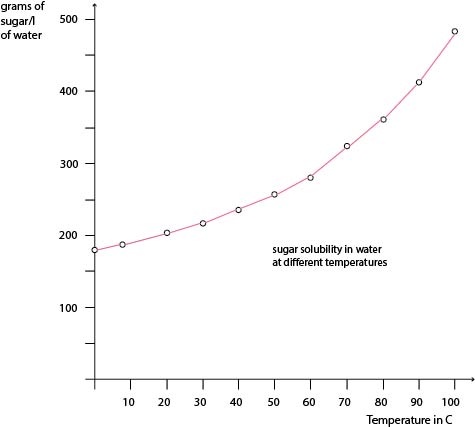
Solubility of sugar in water.
Sugar Syrup
As mentioned above, pure alcohol will not mix with sugar but will mix with sugar syrup. You can dilute 2 kg of sugar in 1 kg of (1 liter) water at room temperature. You can dilute even more sugar in warm water but there is a danger of sugar coming out of the solution when the solution cools down. To prevent this, add a small amount of citric acid (0.08%) or a few drops of lemon juice and boil the syrup for 10-15 minutes. Remove any foam that forms on top. The syrup is stabilized now and sugar will not come out of the solution.
Different sugar syrups can be produced but the following combination saves a lot of time and calculations. Commercial producers like to use 73% sugar syrup (1 kg sugar and 400 ml water) for two reasons:
- Such heavy syrup can be stored for a number of weeks without the risk of developing mold.
- One milliliter of 73% sugar syrup weighs 1 gram. Such syrup is of immense help for making sweet vodkas and liqueurs.
Let's say that the recipe asks for 400 g of sugar per 1 liter of liqueur. All we have to do is to pour 400 milliliters of syrup and the required amount of sugar has been added. There is no need to use a scale, no need to mix, it is clear and ready.
ProcedureAdd sugar slowly to 80° C, 176° F water and mix thoroughly. At 20° C (68° F) sugar becomes saturated at 892 g/1000 ml of water so adding 1000 g/400 ml of water will cross the limit and sugar will come out of the solution when it cools down. To prevent this around 0.08%
(0.8 g per 1 kg of sugar) of citric acid is added and the syrup is boiled for 15 minutes. When sugar is completely dissolved in water and the syrup is clear, remove from heat. Cooking syrup too long will result in a yellowish color. After cooling the sugar will not come out of the solution. If you like to be exact, you may check your syrup; you know that you have mixed 1 kg of sugar with 420 ml of water (extra 20 ml covers boiling loss) but your measuring cylinder says that you have only 975 ml of syrup. Well, you have lost more water during boiling than anticipated so add 25 ml more to make it 1 liter.
| Syrup | Amount of water added to 1 kg of sugar (ml) | Amount of syrup (ml) | Amount of sugar (g) in 1 liter of syrup | Specific gravity at 15° C |
|---|---|---|---|---|
| 73% | 400* | 1000 | 1000 | 1.370 |
| 60% | 670* | 1250 | 780 | 1.290 |
| *You may add an extra 20-50 ml of water to compensate for the boiling loss. 73% sugar syrup is often called normal sugar syrup. | ||||
Many infusion recipes call for mixing equal amounts of sugar with water, i.e. ½ liter of water with ½ kg of sugar. Syrup with such a low sugar concentration must be used within days, otherwise mold will grow and the solution will spoil. Obviously, such an arrangement cannot be accepted by commercial producers who like to keep a large amount of sugar syrup at hand.
If you plan to make sweet vodkas and liqueurs often, preparing syrup in advance is the way to go. Imagine making 1 liter of liqueur nine times in one month. The recipe will call for let's say 450 g of sugar. This means you will have to measure water and sugar, boil the syrup, cool it and wash the dishes nine times. This amounts to many hours of work. It is much easier to get one big pot, pour 1.6 liters of water, add 4 kg of sugar, 3 grams of citric acid and boil it for 15 minutes. There is enough syrup for 9 liters of liqueur; it is ready to be used at a moment's notice and it blends with juice or vodka instantly. And you wash the dishes only once.
There are recipes such as Amaretto and Kahlua that ask for brown sugar. Brown sugar has a nicer flavor, but often is not as refined as the white one. This is why all surface foam should be scooped up when heating sugar syrup. In addition its brown color eliminates its use in clear spirits. It can be used for making dark drinks like chocolate or coffee liqueurs. Brown 73% sugar syrup: 300 g brown sugar, 700 g white sugar, 420 ml water, 0.8 g citric acid. The procedure for making 73% brown sugar syrup follows the steps which were outlined for making white syrup.
Water
Good quality tap water is fine. There are hard waters that contain large amounts of calcium (Ca) or magnesium (Mg) and those should be avoided, especially when used for cooling distillate, as calcium would accumulate on pipes in the form of stone. Secondly, they may add a degree of cloudiness to the finished product which is noticeable only after a few days or even weeks. A common soap does not want to foam well in hard water and that is quite a reliable test. If in doubt, use inexpensive distilled water which does not contain any minerals that could affect the flavor of the product. Water is usually treated with chlorine and sometimes the smell of chlorine may be noticeable. Boiling such water will eliminate this odor.
Vanilla Sugar
Vanilla sugar (German: Vanillezucker, Polish: Cukier waniliowy, Swedish: "Vaniljsocker") is a commonly used ingredient of German, Polish, Swedish, Finnish, Danish, Austrian, Norwegian, Czech, Slovak, Slovenian, Croatian and other European desserts. Vanilla sugar is made of sugar, with vanilla beans or mixed with vanilla extract. It can be costly and difficult to obtain outside Europe but can be simply made at home. Vanilla sugar is easy to make, cheap and versatile. There are many uses for vanilla sugar. Essentially, it can be used in place of regular sugar for making hot drinks and desserts. Vanilla sugar can be added to any recipe that calls for sugar and vanilla. For example Porter Vodka is made with vanilla, sugar or honey. Egg crème is made with vanilla and plenty of sugar. Vanilla sugar fits perfectly into this recipe.
How to Make Vanilla Sugar
Vanilla sugar is very easy to make and requires nothing more than a jar, some fine sugar and vanilla pods. Vanilla sugar can be prepared at home by combining approximately 2 cups of white sugar (400 g) with the scraped seeds of one vanilla bean or one vanilla pod (3 g). Put a vanilla pod into a jar. Split vanilla pods and cut them into 2 to 3 sections. Place in a jar, fill to the top with sugar and shake well. Keep in a cool, dark and dry place, ensuring the lid is airtight. For the best flavor leave it a week before first using. As you use the sugar, replace it with more and shake before putting away. The sugar will keep indefinitely and the pods will need to be replaced annually. Once you use it you might wonder how you ever managed without it.
Honey
Honey is a sweetener that contributes nicely to the taste and aroma. On the negative side, its price recently is so expensive that the choice between sugar and honey will largely depend on how deep your pockets are. Honey's color and flavor depends on the flower from which it originated. Similar to sugar, it also will darken if heated in a frying pan. The color can vary from light yellow to dark brown, and it will obviously influence the final color of the product. In many cases, honey is boiled first in order to remove the foam. This foam contains many small impurities, minuscule parts of bees included, which should be scooped up. There is no need to boil honey if it looks clear. Honey is often fermented to produce honey wine (mead), but that is an entirely new subject. Due to its superior flavor, it is added to high quality infusions and liqueurs.

